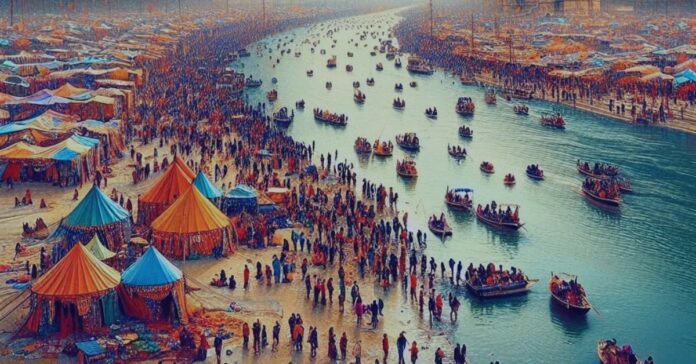In the rich tapestry of Hinduism, there exists a grand spectacle that transcends time and space, weaving together strands of ancient tradition and modern faith into a vibrant tableau of devotion and spirituality. This awe-inspiring spectacle is none other than the Kumbh Mela, a colossal pilgrimage that draws millions of devout souls from every corner of the globe to the sacred banks of India’s holiest rivers – the Ganges, Yamuna, and the mystical Sarasvati. Embark with me on a transformative journey through the heart of this majestic festival as we unravel its ancient origins, explore its contemporary significance, and delve into the myriad rituals that adorn its tapestry of devotion. From the sacred bathing rituals to the congregations of spiritual leaders, the Kumbh Mela is a convergence of ancient wisdom and modern faith, offering a profound glimpse into the spiritual heritage of India and the enduring power of devotion.
The Ancient History/Story of the Festivals
The Kumbh Mela, a grand Hindu festival, traces its origins to ancient Vedic scriptures and mythology. Legend has it that during a celestial battle between the gods and demons over the coveted pot of nectar containing the elixir of immortality, drops of this divine elixir fell to earth at four sacred locations: Prayagraj, Haridwar, Ujjain, and Nashik. These sites are believed to be imbued with extraordinary spiritual potency, becoming focal points for devout pilgrims seeking blessings and spiritual rejuvenation.
The Kumbh Mela is a cosmic congregation, occurring cyclically every 12 years at each of the four sacred locations, rotating in a specific sequence. The festival is a spectacle of faith, culture, and tradition, attracting millions of devotees and curious travelers from around the world. It is a time when ascetics, saints, sadhus, and pilgrims from diverse backgrounds gather to participate in sacred rituals, spiritual discourses, and ceremonial bathing in the holy rivers. The festival is a vibrant tapestry of colors, sounds, and aromas, with elaborate processions, religious performances, and vibrant bazaars enriching the experience.
Partaking in the Kumbh Mela is believed to bestow immense spiritual merit, as it is considered an opportune moment when the gods descend to bless the earth and its inhabitants. Pilgrims seek to purify their souls by immersing themselves in the sacred waters, believing that it cleanses them of sins and releases them from the cycle of birth and rebirth. The festival also serves as a platform for philosophical discussions, cultural exchange, and the preservation of traditional knowledge, making it an invaluable repository of ancient wisdom and practices.
The Kumbh Mela is not merely a religious event; it is a testament to the enduring spiritual heritage of India and the unyielding faith of millions of people. It stands as a symbol of unity, tolerance, and the timeless pursuit of transcendence, transcending boundaries of caste, creed, and nationality. In essence, the Kumbh Mela is a remarkable testament to the profound connection between humanity and the divine, offering a glimpse into the rich tapestry of Indian spirituality and cultural heritage.
The Modern Belief of the Festivals
The tradition of Kumbh Mela has stood the test of time, preserving its essence and significance across millennia, and continues to deeply resonate with devout followers spanning generations. For modern pilgrims, this sacred gathering offers a profound opportunity for spiritual rejuvenation and redemption, serving as a testament to the enduring power of faith to unite humanity in reverence and harmony. It is a time when barriers of caste, creed, and nationality dissolve in the sanctifying waters of the holy rivers, fostering a profound sense of kinship and shared purpose among all who partake in its divine embrace.
The Kumbh Mela is not merely a religious event, but a cultural phenomenon that transcends boundaries, drawing people from all walks of life to partake in the spiritual experience. It serves as a melting pot of diverse traditions, beliefs, and rituals, creating a vibrant tapestry of human expression and devotion. The confluence of millions of pilgrims, ascetics, and seekers creates a unique atmosphere charged with reverence, festivity, and introspection, making it a truly enriching and transformative experience for all who attend.
This sacred gathering also holds historical and mythological significance, with roots that can be traced back to ancient scriptures and legends. It is a time when the celestial and earthly realms are believed to converge, and the rivers are believed to be infused with divine blessings, offering a chance for spiritual purification and enlightenment.
The enduring allure of Kumbh Mela lies in its ability to transcend time and space, creating an inclusive and egalitarian platform where people from diverse backgrounds come together to celebrate their shared humanity and spiritual quest. It stands as a testament to the unifying power of faith and the timeless relevance of ancient traditions in the modern world.
Gods/Goddesses Worshipping
The Kumbh Mela festival is centered around the worship of a variety of Hindu deities, each with their own unique attributes and revered for their divine grace. From the celestial trinity of Brahma, Vishnu, and Shiva to the goddess Ganga, who embodies the sacred river, the presence of these benevolent beings suffuses every aspect of the festival. Pilgrims seek the blessings of these deities as they pursue spiritual fulfillment and transcendence.
Significance & Importance of the Festivals
The significance of Kumbh Mela extends far beyond its ritualistic observance; it serves as a timeless testament to the enduring vitality of Hindu culture and civilization. As the largest religious gathering on earth, it stands as a beacon of hope and inspiration for millions, reaffirming the eternal truths of dharma (righteousness), karma (action), and moksha (liberation) that lie at the heart of Hindu philosophy. Moreover, it is a testament to the profound bond between humanity and the natural world, reminding us of our interconnectedness with the cosmos and the sacredness of all creation.
How You Should Celebrate the Festivals
Participating in Kumbh Mela is not merely an act of attendance but a sacred pilgrimage requiring devotion, discipline, and reverence. Here’s a guide on how to immerse yourself fully in its divine ambiance:
- Pooja and Rituals: The Kumbh Mela festivities are punctuated by elaborate rituals and pujas, performed with meticulous precision to honor the divine. From the rhythmic chants of mantras to the offering of sacred offerings, devotees partake in rituals that symbolize their devotion and surrender to the divine.
- Fasting: Fasting during the Kumbh Mela is a common practice, believed to purify the body and mind, enabling devotees to deepen their spiritual connection with the divine.
- Dance and Music: The air pulsates with the rhythm of devotional songs and the graceful movements of traditional dance forms. Dance and music serve as conduits for spiritual expression, elevating the collective consciousness of pilgrims.
- Community Celebrations: Beyond individual devotion, the Kumbh Mela fosters a sense of community and camaraderie among pilgrims. It is a time of shared joy, where people from diverse backgrounds come together in pursuit of spiritual fulfillment.
- Food: No festival is complete without a feast for the senses. The Kumbh Mela tantalizes taste buds with a myriad of culinary delights, ranging from traditional Indian sweets to savory delicacies, uniting pilgrims in a gastronomic celebration of culture and tradition.
Other Information
- Location: Kumbh Mela is held cyclically at four sacred sites: Prayagraj (also known as Allahabad), Haridwar, Ujjain, and Nashik, each hosting the festival once every twelve years.
- Specific Time to Celebrate: The timing of Kumbh Mela is determined by the auspicious alignment of astrological factors, with the festival occurring at intervals of twelve, six, or three years, depending on the planetary configurations.
- Dress Code: While there is no strict dress code for Kumbh Mela, pilgrims often don traditional attire such as dhotis, saris, and kurta-pajamas, reflecting the cultural diversity and heritage of India.
Conclusion
In the rich tapestry of human existence, few events can match the grandeur and splendor of Kumbh Mela. This sacred pilgrimage brings together millions of devotees from diverse backgrounds, uniting them in a shared experience of faith, tradition, and spiritual transcendence. As we bid farewell to this awe-inspiring gathering, let us carry with us the profound blessings and insights gained from the hallowed grounds, remaining ever cognizant of the timeless truths that bind us together on our collective journey towards the divine. May the enduring spirit of Kumbha Mela continue to serve as a wellspring of inspiration and upliftment for humanity, lighting the path of righteousness and enlightenment for countless generations to come.








